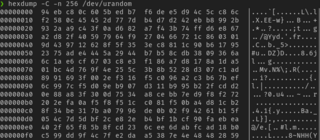Blowfish is a symmetric-key block cipher, designed in 1993 by Bruce Schneier and included in many cipher suites and encryption products. Blowfish provides a good encryption rate in software, and no effective cryptanalysis of it has been found to date for smaller files. It is recommended Blowfish should not be used to encrypt files larger than 4GB in size, Twofish should be used instead.

GNU Privacy Guard is a free-software replacement for Symantec's cryptographic software suite PGP. The software is compliant with RFC 4880, the IETF standards-track specification of OpenPGP. Modern versions of PGP are interoperable with GnuPG and other OpenPGP v4-compliant systems.

Daniel Julius Bernstein is an American mathematician, cryptologist, and computer scientist. He is a visiting professor at CASA at Ruhr University Bochum, as well as a research professor of Computer Science at the University of Illinois at Chicago. Before this, he was a visiting professor in the department of mathematics and computer science at the Eindhoven University of Technology.

A cryptographic hash function (CHF) is a hash algorithm that has special properties desirable for a cryptographic application:
In cryptography, Tiger is a cryptographic hash function designed by Ross Anderson and Eli Biham in 1995 for efficiency on 64-bit platforms. The size of a Tiger hash value is 192 bits. Truncated versions can be used for compatibility with protocols assuming a particular hash size. Unlike the SHA-2 family, no distinguishing initialization values are defined; they are simply prefixes of the full Tiger/192 hash value.
In cryptography, Camellia is a symmetric key block cipher with a block size of 128 bits and key sizes of 128, 192 and 256 bits. It was jointly developed by Mitsubishi Electric and NTT of Japan. The cipher has been approved for use by the ISO/IEC, the European Union's NESSIE project and the Japanese CRYPTREC project. The cipher has security levels and processing abilities comparable to the Advanced Encryption Standard.
In computer science and cryptography, Whirlpool is a cryptographic hash function. It was designed by Vincent Rijmen and Paulo S. L. M. Barreto, who first described it in 2000.

In Unix-like operating systems, /dev/random and /dev/urandom are special files that serve as cryptographically secure pseudorandom number generators (CSPRNGs). They allow access to a CSPRNG that is seeded with entropy from environmental noise, collected from device drivers and other sources. /dev/random typically blocked if there was less entropy available than requested; more recently it usually blocks at startup until sufficient entropy has been gathered, then unblocks permanently. The /dev/urandom device typically was never a blocking device, even if the pseudorandom number generator seed was not fully initialized with entropy since boot. Not all operating systems implement the same methods for /dev/random and /dev/urandom.
Bart Preneel is a Belgian cryptographer and cryptanalyst. He is a professor at Katholieke Universiteit Leuven, in the COSIC group.
SHA-2 is a set of cryptographic hash functions designed by the United States National Security Agency (NSA) and first published in 2001. They are built using the Merkle–Damgård construction, from a one-way compression function itself built using the Davies–Meyer structure from a specialized block cipher.
In Unix computing, crypt or enigma is a utility program used for encryption. Due to the ease of breaking it, it is considered to be obsolete.

Gpg4win is an email and file encryption package for most versions of Microsoft Windows and Microsoft Outlook, which utilises the GnuPG framework for symmetric and public-key cryptography, such as data encryption, digital signatures, hash calculations etc.

KDE Wallet Manager (KWallet) is free and open-source password management software written in C++ for UNIX-style operating systems. KDE Wallet Manager runs on a Linux-based OS and Its main feature is storing encrypted passwords in KDE Wallets. The main feature of KDE wallet manager (KWallet) is to collect user's credentials such as passwords or IDs and encrypt them through Blowfish symmetric block cipher algorithm or GNU Privacy Guard encryption.

In cryptography, the OpenPGP card is an ISO/IEC 7816-4, -8 compatible smart card that is integrated with many OpenPGP functions. Using this smart card, various cryptographic tasks can be performed. It allows secure storage of secret key material; all versions of the protocol state, "Private keys and passwords cannot be read from the card with any command or function." However, new key pairs may be loaded onto the card at any time, overwriting the existing ones.
In cryptography, Curve25519 is an elliptic curve used in elliptic-curve cryptography (ECC) offering 128 bits of security and designed for use with the Elliptic-curve Diffie–Hellman (ECDH) key agreement scheme. It is one of the fastest curves in ECC, and is not covered by any known patents. The reference implementation is public domain software.
Mbed TLS is an implementation of the TLS and SSL protocols and the respective cryptographic algorithms and support code required. It is distributed under the Apache License version 2.0. Stated on the website is that Mbed TLS aims to be "easy to understand, use, integrate and expand".
Nettle is a cryptographic library designed to fit easily in a wide range of toolkits and applications. It began as a collection of low-level cryptography functions from lsh in 2001. Since June 2009 Nettle is a GNU package.
SipHash is an add–rotate–xor (ARX) based family of pseudorandom functions created by Jean-Philippe Aumasson and Daniel J. Bernstein in 2012, in response to a spate of "hash flooding" denial-of-service attacks (HashDoS) in late 2011.
In public-key cryptography, Edwards-curve Digital Signature Algorithm (EdDSA) is a digital signature scheme using a variant of Schnorr signature based on twisted Edwards curves. It is designed to be faster than existing digital signature schemes without sacrificing security. It was developed by a team including Daniel J. Bernstein, Niels Duif, Tanja Lange, Peter Schwabe, and Bo-Yin Yang. The reference implementation is public-domain software.
The tables below compare cryptography libraries that deal with cryptography algorithms and have application programming interface (API) function calls to each of the supported features.






